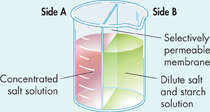Think Critically
Predict The beaker in the diagram below has a selectively permeable membrane separating two solutions. Assume that both water and salt can pass freely through the membrane. When equilibrium is reached, will the fluid levels be the same as they are now? Explain.

Predict What would happen to a sample of your red blood cells if they were placed in a hypotonic solution? Explain.
Design Experiments You are given food coloring and three beakers. The first beaker contains water at room temperature, the second beaker contains ice water, and the third beaker contains hot water. Design a controlled experiment to determine the effects of temperature on the rate of diffusion. Be sure to state your hypothesis.
7.4 Homeostasis and Cells
Understand Key Concepts
Which of the following is true of ALL single-celled organisms?
They are all prokaryotes.
They are all bacteria.
They all reproduce.
They all have a nucleus.
A tissue is composed of a group of
similar cells.
related organelles.
organ systems.
related organs.
Explain the relationship among cell specialization, multicellular organisms, and homeostasis.
Describe the relationship among cells, tissues, organs, and organ systems.

solve the CHAPTER MYSTERY

DEATH BY… WATER?
During the race, Michelle drank plenty of water, but she didn't replace the salts she lost due to sweating. As a result, her blood became hypotonic, and osmotic pressure led the cells in her brain (and throughout her body) to swell.
As Michelle's blood became more dilute, cells in her brain sent chemical signals to her kidneys to stop removing sodium chloride and other salts from her bloodstream. However, as she continued to sweat, she continued to lose salt through her skin.
By the end of the race, Michelle had lost a large quantity of salt and minerals and had taken in so much water that homeostasis had broken down, and her cells were damaged by unregulated osmotic pressure.
When Michelle was rushed to the hospital, the doctors discovered that she was suffering from hyponatremia, or water intoxication. Left untreated, this condition can lead to death.
Relate Cause and Effect When a person sweats, water and essential solutes called electrolytes are lost from body fluid. Michelle drank lots of water but did not replace lost electrolytes. What effect did this have on her cells?
Infer Had Michelle alternated between drinking water and a sports drink with electrolytes would her condition be the same?
Infer Do you think that hyponatremia results from osmosis or active transport? Explain your reasoning.
Connect to the
 Explain how hyponatremia disrupts homeostasis in the body.
Explain how hyponatremia disrupts homeostasis in the body.
Table of Contents
- Formulas and Equations
- Applying Formulas and Equations
- Mean, Median, and Mode
- Estimation
- Using Measurements in Calculations
- Effects of Measurement Errors
- Accuracy
- Precision
- Comparing Accuracy and Precision
- Significant Figures
- Calculating With Significant Figures
- Scientific Notation
- Calculating With Scientific Notation
- Dimensional Analysis
- Applying Dimensional Analysis




